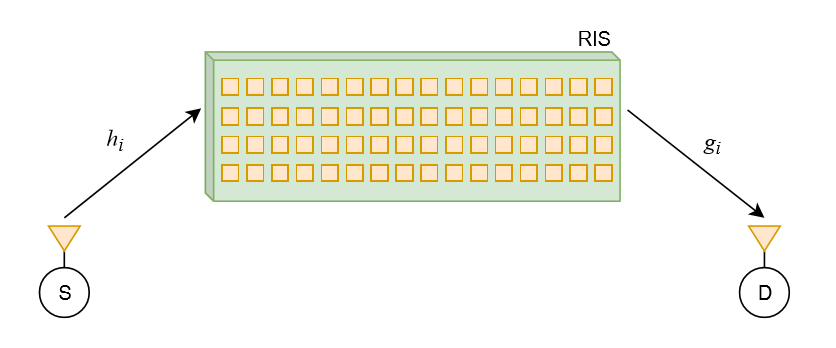Wireless channel is inherently unpredictable and this results in loss of information as it travels from the transmitter to the receiver. The main reason for this is that multiple copies of the wireless signal arrive at the receiver which sometimes add constructively and at other times destructively, causing deep fades. The deciding factor between signal copies (think of them as echoes) adding constructively or destructively is the relative phase. If the phases are aligned the signals add up but if the phases are not aligned, we get a fade (fades can be as deep as 60-80dB). Wireless engineers over the years have worked around this problem by using multiple antennas also called antenna arrays.
For now, let us assume that there is no temporal variation of the wireless signal amplitude. The transmitter, the receiver and the environment are stationary. In such a case the relative phase between the signal copies arriving at the receive antenna array depends purely upon the environment geometry. It has been known for a long time that signal copies arriving at the array elements can be aligned by multiplication with complex weights after which these copies can be added together. It may come as surprise that this weighting can be done both at the transmitter and the receiver and is called beamforming. Beamforming essentially gives preference to signals arriving from a particular direction and negates signals arriving from unwanted direction. This preference for a certain direction is called directivity.

Transmit or receive beamforming has been around for a long time and it works like magic. But there is a down side to it; antenna arrays require multiple RF chains which can be a power hungry and expensive solution. What if instead of aligning the copies at the transmitter or receiver we do it while the signal is under transmission in the channel; this is achieved through a Reconfigurable Intelligent Surface (RIS), an electromagnetic surface which is much larger than the wavelength under consideration. A simple analysis in [1] has shown that for a two-ray geometry (LOS plus ground reflected ray) RIS can make the power fall of as the second power of distance rather than the fourth power. When multiple meta-surfaces are combined to form an RIS there is an additional power gain proportional to square of the number of meta-surfaces e.g. if an RIS with 100 elements is used we get a gain of 10log10(1002)=40dB.
The main advantages of RIS over other techniques such as MIMO, Relaying, Beamforming and Backscatter Communication are given below.
- RIS is nearly passive, and, ideally, does not need any dedicated energy source.
- RIS can be viewed as a contiguous surface, and, ideally, any point can shape the wave impinging upon it.
- RIS is not affected by receiver noise, since, ideally, it does not need analog-to-digital or digital-to-analog converters, and power amplifiers.
- RIS has full-band response, since, ideally, it can work at any operating frequency.
- RIS can be easily deployed, e.g., on the facades of buildings, ceilings of factories and indoor spaces, human clothing, etc.
Open Questions
After reading a few research papers and watching couple of YouTube tutorials, I am still not clear how is the RIS going to adjust the weights so that a beam is formed in the desired direction, the direction of the mobile user, that otherwise does not have a direct LOS with the base station. It seems that there has to be some feedback mechanism from the receiver to the RIS indicating the phase shifts required and a controller at the RIS that would obviously need some power to operate. So, the RIS would not be a totally passive device as claimed by most researchers. It is also not clear what would be the power source for the RIS. If its battery operated, how long would the battery last before it has to be charged or replaced. Lastly how many intelligent surfaces would be required per square km or per cell site as this would directly influence the infrastructure cost.
Notes
- At a frequency of 30GHz i.e. at the lower end of the millimeter wave band, the wavelength is 1cm. A reasonably sized meta-surface (one element of an RIS) could have dimensions of 10cm x 10cm resulting in a surface area of 100cm2. An RIS with 100 of such meta-surfaces would have an area of 1m2, which seems practical.
- According to published research results the IRS works best when it is placed close to the transmitter or receiver. When placed close to the base station this technique is also called holographic beamforming.
- The usefulness of multipath has been known for a long time. In his Cellular Communication class of Fall 2000, at Virginia Tech, Dr. Ted Rappaport informed the class that the CDMA Rake Receiver likes multipath so much that sometimes artificial reflectors are put around in the environment to create multipath when there is none. That might have been the first intelligent surface to be ever used in Cellular Communications.
References
[1] Ertugrul Basar, Senior Member, IEEE, Marco Di Renzo, Senior Member, IEEE, Julien de Rosny, Merouane Debbah, Fellow, IEEE, Mohamed-Slim Alouini, Fellow, IEEE, and Rui Zhang, Fellow, IEEE “Wireless Communications Through Reconfigurable Intelligent Surfaces,” arXiv eess.SP.
One thought on “Reconfigurable Intelligent Surfaces Explained”
You may find some answers to the open question you mentioned in these papers:
[1] https://arxiv.org/abs/1904.10136
[2] https://arxiv.org/abs/2002.11101